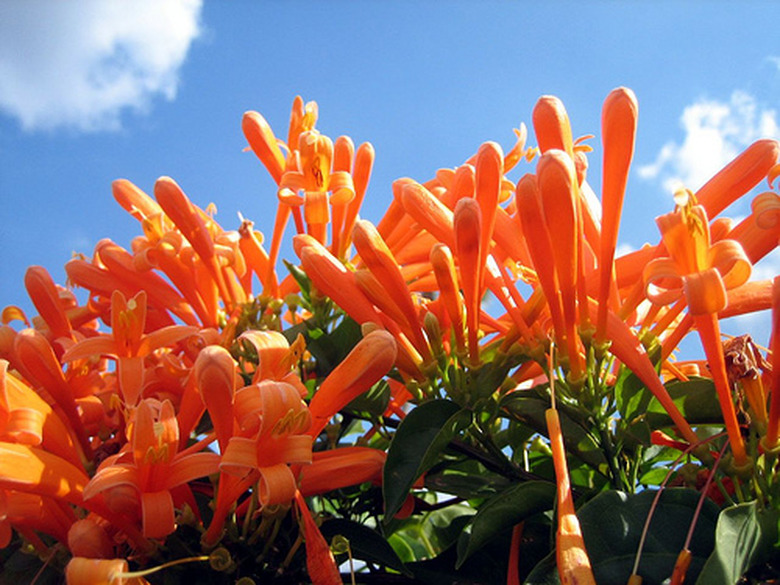How To Grow Flame Vine
Things Needed
- Flame vine
- Peat moss
- Compost or mulch
- Fertilizer
- Water
- Clippers
Flame vines are subtropical plants that can grow in U.S. Zones 9 to 11. They bloom bright orange flowers during the winter months, typically in January and February. They are hardy vines that can grow in most soils and resist an occasional frost. Flame vines reach heights of 30 feet or more.
Step 1
Purchase a flame vine, take a cutting off an existing one or start a new plant by air layering.
A cutting refers to simply cutting off an existing piece of a vine, usually about eight inches. Plant it in a pot with all-purpose potting soil, cut side down and place the pot next to a sunny window. Keep it evenly moist and wait for it to take root, usually a couple of weeks, before transplanting it outside. If desired, dip the stem one inch deep in rooting hormone, available at most garden stores, prior to potting for faster growth.
- Flame vines are subtropical plants that can grow in U.S.
- Zones 9 to 11.
- Keep it evenly moist and wait for it to take root, usually a couple of weeks, before transplanting it outside.
Air layering means that you girdle, or strip off, a couple inches of the outer layer (bark) of a branch near the ground while it is still part of a vine. Cover the girdled area with moist peat moss, continue to water and wait for it to grow roots. Then cut the entire branch off to plant the new roots in a new location.
Step 2
Choose a location in full sun or partial shade. Flame vines cling well to fences, trellises, walls and arbors. They can tolerate most soils; however, to encourage faster growth, if your soil is not rich or well draining, till in a couple inches of compost, peat moss or sand prior to planting.
Step 3
Dig a hole that is several inches deep and wide. Place the flame vine in the hole and back fill it with soil. Plant multiple vines about three to five feet apart. Water well and keep the soil moist for the first few weeks. Thereafter, you should not need to water flame vines unless drought conditions exist.
- Air layering means that you girdle, or strip off, a couple inches of the outer layer (bark) of a branch near the ground while it is still part of a vine.
- They can tolerate most soils; however, to encourage faster growth, if your soil is not rich or well draining, till in a couple inches of compost, peat moss or sand prior to planting.
Step 4
Fertilize flame vines the first year starting in early spring. Use an all purpose low dose fertilizer. Repeat as directed on the packaging since each brand of fertilizer has different release rates. Once or twice more should be sufficient.
Step 5
Prune flame vines each year after blooming. Cut back to shape and to remove dead and damaged branches. To encourage more growth and blooms, cut back to about three feet from the ground. In addition, it is important to keep the vines away from other flowers and shrubs. Flame vines will not only take over the area, creating a disorganized space, they can strangle the other plants.
- Fertilize flame vines the first year starting in early spring.
- To encourage more growth and blooms, cut back to about three feet from the ground.
